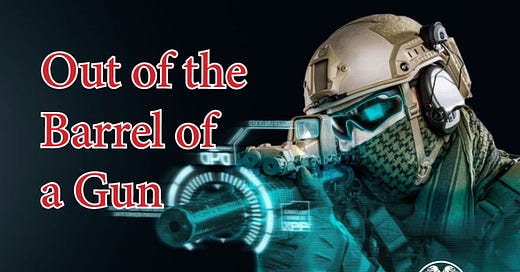A video recently made the rounds, of Alex Karp telling us why America is supreme in modern warfare:
This is crucial for the West and all of our allies who primarily love the freedoms and liberties we have, to show to our adversaries that we are in fact superior at modern warfare—which I would define as tech-enhanced, kinetic attack weapons.
This reads less like a statement of fact and more like a daily affirmation, not least because of the video’s mantra-like repetition of freedom, liberty etc.—but above all, because it’s simply not true. The West may be militarily superior, but Karp massively overstates it, and the gap is closing every day. And it’s closing because his definition of modern warfare is wrong.
Karp is the CEO of Palantir, a data analytic firm whose main customer is the US intelligence community, so he knows very well what modern warfare is about. It’s about much more than writing software to perform on the battlefield—that’s last century’s warfare, 4G warfare (4GW) at best. We have moved into 5GW, and it’s here that the West no longer enjoys an advantage. To understand why, we need to understand how warfare has changed over the centuries, so let’s trace out the generations of warfare as military historians understand them.
1GW: Line and Column — Born in the ancient world, perfected in the Napoleonic era. A highly disciplined form of warfare involving elaborate movements of large numbers of men. This required a professionalized military culture distinct from civilian life, and gave us the hierarchical command and control military culture we know today—the main strategy is maneuver.
2GW: Industrial — Born in the industrial revolution, perfected in WWI. Developing out of steam and mass production, this was where technology revolutionized warfare in the modern age. The main technology is artillery, along with radio, chemicals, barbed wire, etc. Made 1GW obsolete by imposing mass casualties—the main strategy is attrition.
3GW: Blitzkrieg — Born in WWI, perfected in Korea. An extension of 2GW but differentiated by increased mobility from development of the internal combustion engine. Tank, air force, missile technologies are used, not to meet the enemy head on, but to overcome him with speed and surgical strike capability. Made 2GW obsolete by breaking through lines and striking at deep targets—the main strategy is again maneuver.
4GW: Irregular/guerrilla — Born in Vietnam, perfected in Afghanistan. The beginning of true asymmetrical warfare. The lines between friend and enemy are blurred, disadvantaging the aggressor by imposing operational costs both monetary and psychological. Made 3GW obsolete by obscuring the front and prolonging campaigns—the main strategy is again attrition, by way of confusion.
5GW: Informational — Born in the Cold War. An extension of 4GW using modern media. Warfare is largely conducted by way of misinformation, foreign influence campaigns, conspiracy theory, colour revolutions, and demoralization, to impose costs not only on fighting, but on governing. Made 4GW obsolete by moving the main front from the battle to home. Friend-enemy is completely blurred, ‘terrorists’ are everywhere, institutional trust collapses. Total operational asymmetry—main strategy is again attrition, now by way of ideology.
There are a few things to note about the generations of warfare.
First, each successive generation of warfare renders the last one obsolete by either obviating or eclipsing its strategy. Warfare is increasingly abstracted from violence, which in liberal societies necessitates a redefinition of violence in order to maintain the illusion that the state is concerned only with harm and not, say, social engineering or nation building.
Second, the general (though not universal) trend is toward lower cost operations, at least as a percentage of, let’s just call it anachronistically, GDP. 1GW requires a martial culture or mass conscription, 2GW dispenses with martial culture, and even conscription until much later. 3GW is exceptional in that its technical requirements demand a more total mobilization, involving even women in factories. 4GW cuts this into a fraction, and 5GW a fraction of a fraction.
Third, following on from the last point, is that warfare is increasingly asymmetrical, especially since 4GW. War can now be waged with only a computer and an internet connection. What’s more, warfare is now ideologically asymmetrical. Because 5GW is ideological warfare and is waged mostly on the home front, the ideology on the home front is decisive, and liberalism comes up short. A society must not only demoralize its enemies, but must embolden its own citizens, who are defending not just a people but an idea—in the case of liberalism, the idea of freedom. But this idea is harder and harder to maintain as liberal societies, in order to wage 5GW, must increasingly police speech, thoughts, and information flows—to win at 5GW you must be totalitarian. Every society of course has always been totalizing, but liberalism is faced with an impossible choice between security and its basic proposition—both are existential threats.
With all this in mind, Alex Karp’s comments seem especially absurd.




